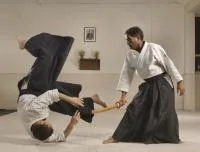An attact can happen to anyone, at any age, in any place. There are some tips on what you can do in such a situation.
1. Avoid and Prevent
It is best to avoid isolated, dark places. Avoid dressing provocatively – you are inviting trouble.
2. Be aware of your surroundings
In a potentially dangerous place increase your level of alertness. Be aware of who is walking in front of you and behind you. Mentally be prepared for any eventuality.
3. Be firm. Show no fear
If someone makes suggestive remarks to you, be calm, firm, do not insult or inflame the potential aggressor. Show no fear. Immediately head or run towards a safer place.
4. Run
Even if you are trained in martial arts, Running away is still the most sensible option.
5. Never turn your back on a potential aggressor
Attacks frequently happen from behind, unexpectedly.
6. Take your dog on a leash
If you have your dog with you but he is non-aggressive (not likely to attack human beings), immediately take him on the leash and keep close to yourself. Any threat to you will be interpreted by your dog as a threat to him. His aggressive pose, growling or barking is likely to scare off the aggressor.
7. Yell for help
If you have been attacked, do not be shy to shout for help. Yell as loudly as possible, even if there is no one around.
8. Fight on
Do not feel inhibited if your clothes are torn during the fight. When the situation is over, you will receive all necessary help from people/police.
9. Pick up objects of self-defense
Ordinary objects like sticks, rocks, a handbag, an umbrella, keys or a pen can be used. Shoe heals are powerful weapons. Do no hesitate to inflict pain to the aggressor – your life is in danger.
10. Painful/critical points on the body
Temples, eyes, throat, septum of the nose, solar plexus area, groin, knee caps, shin bone, instep (for a heal attack), armpits.
11. Do not loose your mind
Calculate: what is really happening? what is the worst thing that can happen? what are the possible options? what is the best option for you NOW? Then act accordingly and decisively.
12. Assess the threat
An aggressor may threaten to use a knife on you. Access whether the knife threat is real or not. Access whether the attacker is alone or his buddies are nearby.
13. Do not get paralyzed with fear. Do not panic. Do not attribute any powers to the attacker
Put up a resistance. Look for a weakness in your attacker. Look for an opening. Pre-empty. Never mentally assume that your attacker is more powerful than you.
14. In case of a ground fight, do not give up
Continue resistance. Make yourself a hard target. Your endurance for a length of time may wear out your aggressor.
15. Maintain the presence of mind
During a fight, both the sides are in an altered psychological state: their powers are increased manifold, they feel no pain. In such a situation, a person who maintains the presence of mind, who is not overcome with emotion wins.
Remember, people under the influence of narcotic drugs, FEEL NO PAIN. Physical injuries will not deter them.
16. Invoke for Divine guidance, help and protection
In comes as the last point, but this is the first thing I personally advise you to do.
(Yulia Pal. September 2008)





